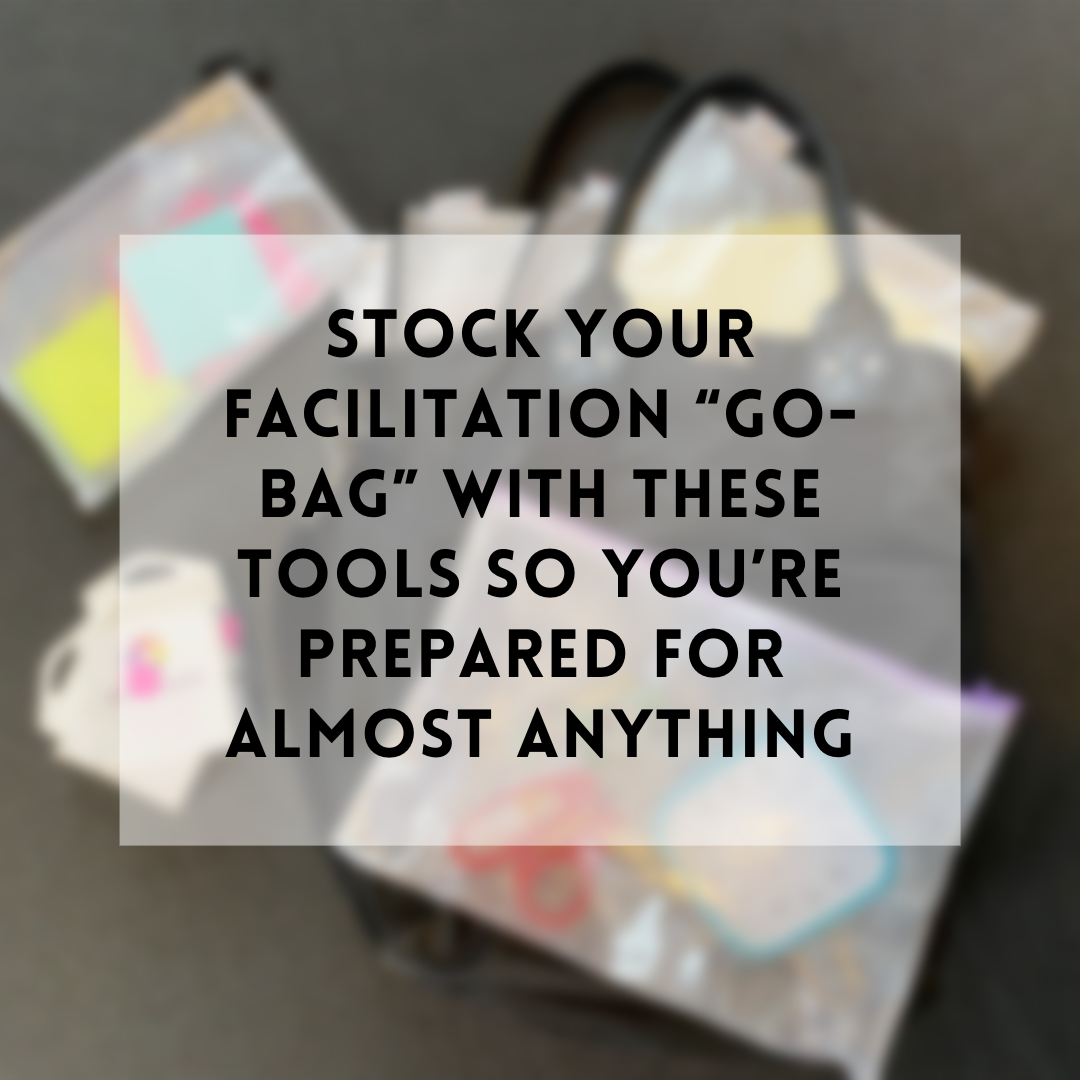Stock your facilitation “go-bag” with these tools so you’re prepared for almost anything
Have you ever showed up to lead a workshop and found that all the whiteboard markers were dried out? Or nobody brought pens? Or there wasn’t any paper on hand for sketching exercises?
With the return of more in-person work comes the return of more in-person workshops, and that means that we facilitators need to be prepared with the right toolkit for live gatherings.
The last thing any of us wants to do is lead without the optimal materials (or deal with the ensuing panic of finding yourself without them), so I’ve put together a list of the items that I keep in my facilitation “go-bag” at all times, including:
Clear zipper bags
Everything I carry gets organized into clear, flat, zip-close bags of different sizes so that I can quickly and easily see what’s inside of them. They’ll save you from digging through all your stuff to find things, and help you organize similar items together. I use them for everything, which means that all the tools that follow on this list are organized into their own clear zipper bags.
Plenty of 8 ½” x 11” blank paper
I always keep a stack of printer paper with me to support drawing and sketching exercises. This way I know we’ll never be short on drawing materials, and that all participants will have a consistent format to work from.
Pads of sticky notes in my favorite size and color: canary yellow 3” x 5” Post-Its
This is my go-to variety that I have participants use almost exclusively. Why? They’re just the right size to support drawing and writing exercises, allowing just enough detail to be included, but not too much. I also like offering a single color to the group because it keeps the room from feeling overwhelming when they’re all pasted up on the wall.
Square sticky notes in two colors
These Post-Its are used exclusively by me, the facilitator, to help highlight themes, create labels, identify categories, number items, make note of decisions, and generally organize information that’s posted around the room. My favorite colors to use are pink and blue because they’re distinct from one another, and very clearly different from the canary yellow Post-Its the participants use.
Writing instruments
I keep a bag with two kinds of pens and always hand out one of each to my participants to support their writing and sketching exercises. First, a fine-point Sharpie in black ink, which I love because they’re a little bolder and keep people from including too many details too early on. Second, a felt-tip Papermate Flair pen, which is a nice alternative to Sharpies, as they can sometimes be stinky and off-putting to folks.
Markers
This bag includes both whiteboard and flip-chart markers in multiple colors. Sometimes you’ll use both surfaces, sometimes you won’t. Best to be prepared with the right markers for each. That said, I have to confess that I usually just default to my whiteboard markers for everything so that I don’t have to switch back and forth between instruments when I’m moving between boards. Either way, more is more here. There’s nothing like a dried-out marker to ruin your day.
Hard goods
This bag includes one or two timers (multiple are helpful if you do breakout groups), and scissors, masking tape, scotch tape, and white out. The latter items support making modifications to sketching exercises, like cutting things up, taping them together, and/or affixing drawings to walls. I also keep a second, smaller bag on hand with batteries and a tiny screwdriver in case I need to change out the battery on my timers, because you never know!
Sticky dots
If you’re running any voting or heat-mapping exercises, sticky dots are critical to have in your toolkit. I love using two different variations: the .75” fluorescent pink dot from Chromalabel, and the ¼” light blue or green dot from Chromalabel. I also keep a Ziploc inside this bag with leftover sheets where I collect old dots to reuse later.
Binder clips
I love having some clips on hand because you never know when you might need to group a stack of papers or Post-Its together. I always use a few jumbo-size clips on the bottom of big flip-charts to keep the pages together (which is a lot easier for load-in and load out).
Tech accessory bag
These items don’t get too much use, but I like to have them just in case, including a flash drive, some dongles and a clicker. I’ve been in a workshop before where the tech failed and I needed to move an entire presentation from my computer to another device in order to present. Good thing I had a USB!
Personal goodies
I also make sure that my needs are covered during a workshop so I can feel comfortable and energized for the long haul. Inside my main bag I keep a bundle of personal items, including chapstick, a mask, eyedrops, hand lotion, toothpicks and a mini-sewing kit. If my wardrobe malfunctions or I feel food stuck in my teeth, I know it won’t cause delays to the workshop because I’ve got the gear to stay cool.
I keep all of these items stocked and ready to go at any given time. If there’s anything I’ve learned in my years of facilitation, it’s that you can’t control everything, but you can certainly be prepared for almost anything.

